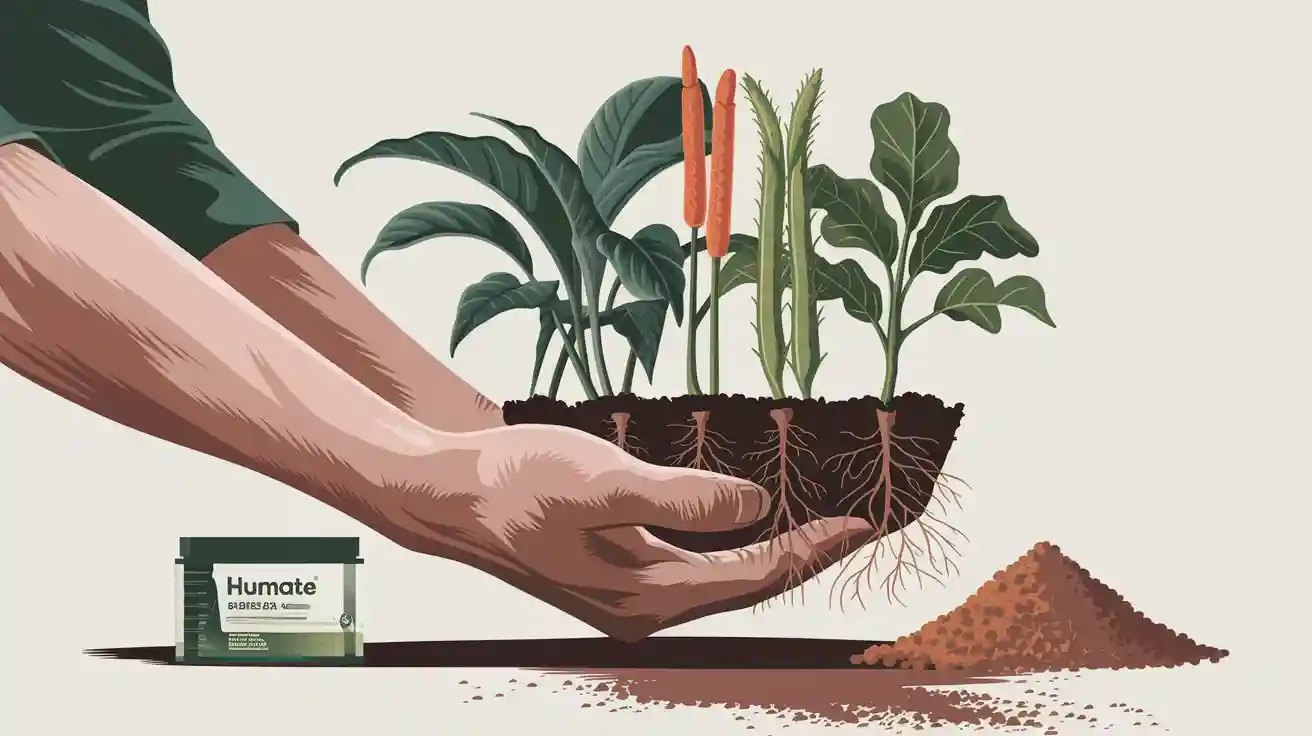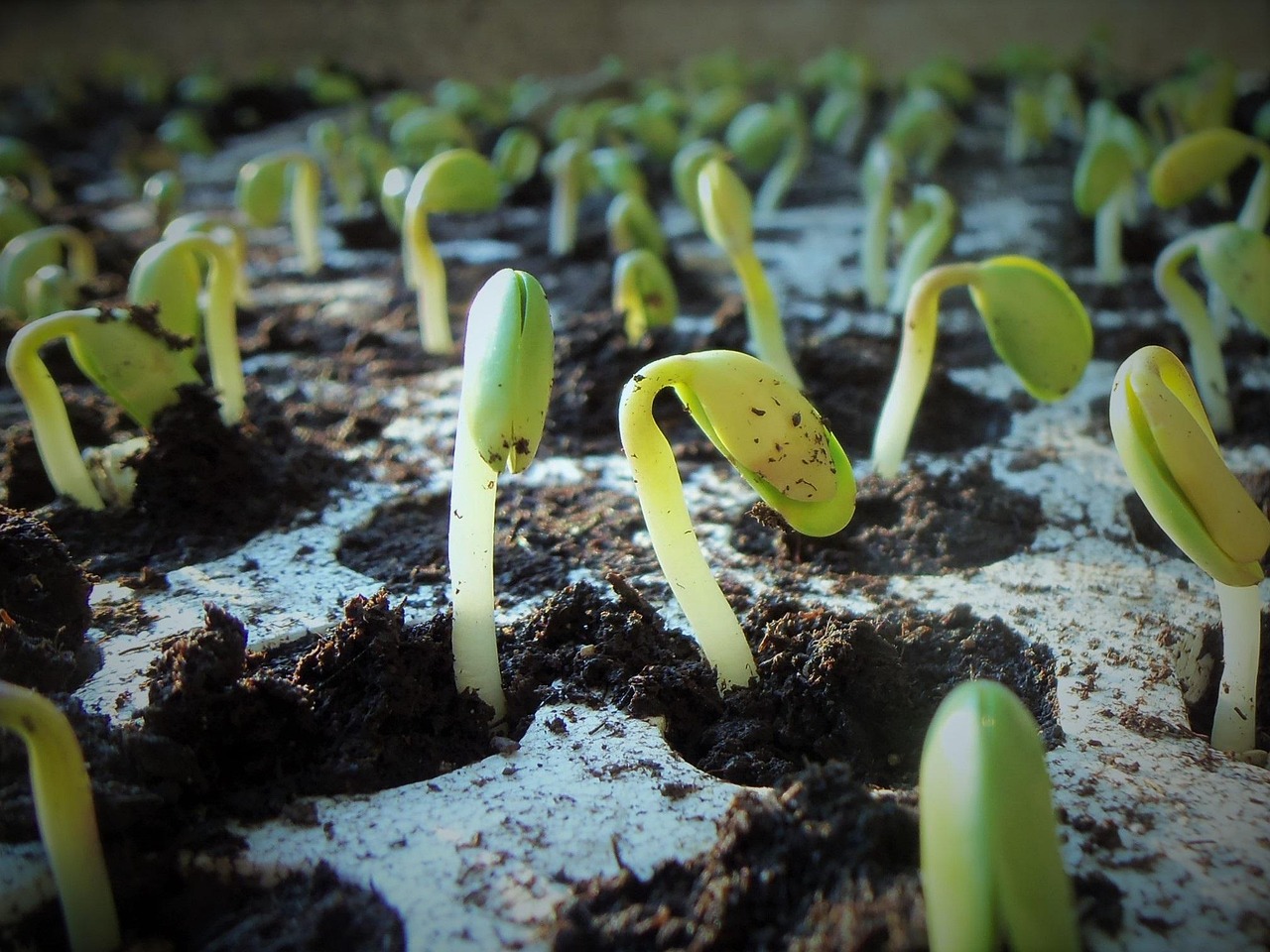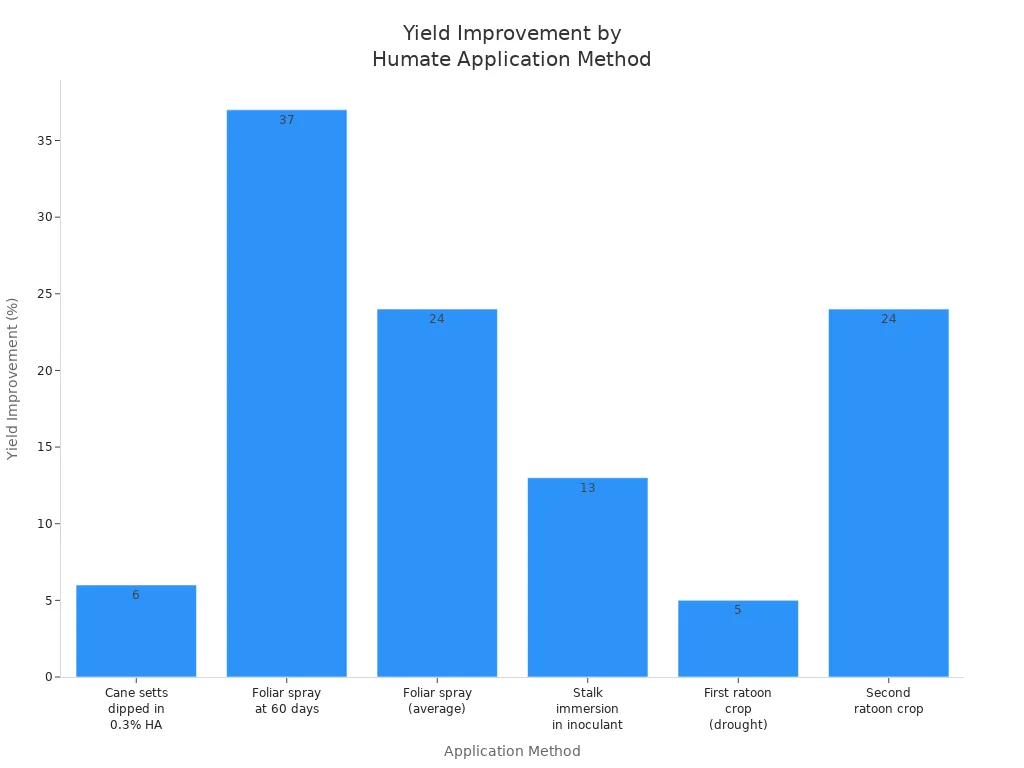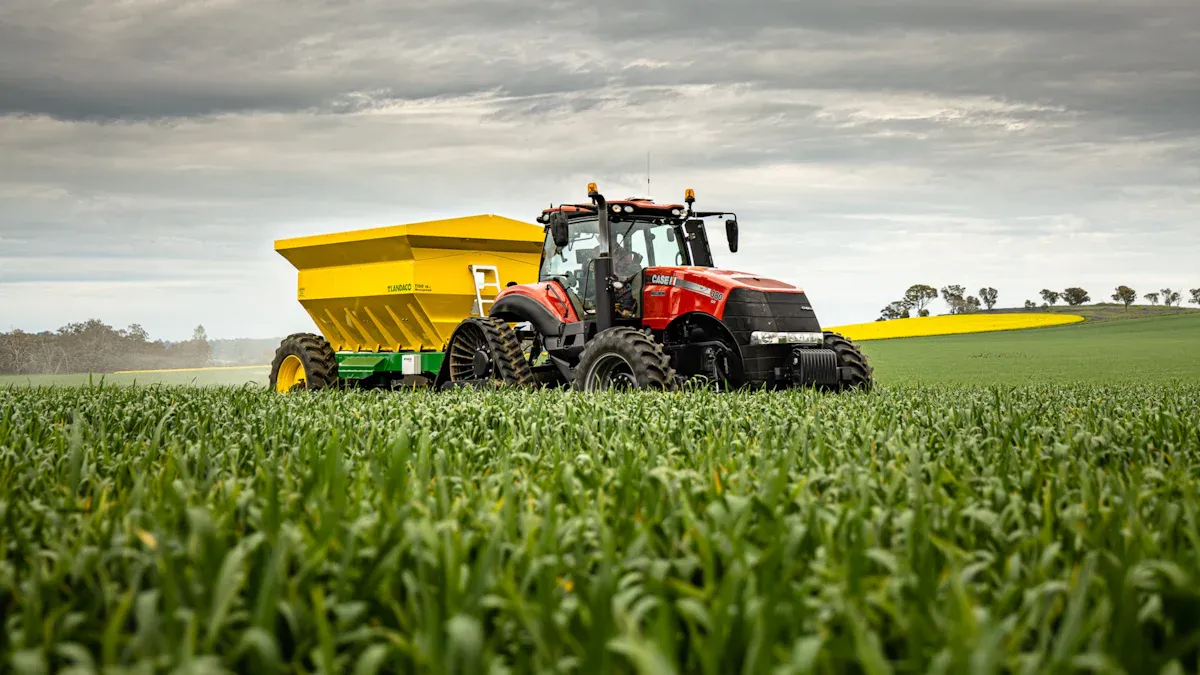Which plants in Brazil need humate fertilizer

If you grow soybeans, common beans, tomatoes, peppers, butter kale, fruit trees, ornamentals, or native plants like eucalyptus, humate fertilizer can help them. It makes your plants healthier and helps them grow more food. In Brazil, soils are different in many places. This product helps roots grow better. It also helps plants make more nodules and get more nitrogen.
Growth Parameter | Most Effective K-humate Dose (mg/L) | Observed Benefit |
|---|---|---|
Bradyrhizobium survival | Best survival on seeds | |
Root length and volume | 50–4000 | Roots grow bigger |
Nodulation and biomass | 50 | Best for plant growth |
Nitrogen content in shoots | 50 | Most nitrogen found |
Think about how your plants could get stronger roots and better soil.
Key Takeaways
Humate fertilizer helps many plants in Brazil. It makes roots stronger and helps plants make more food. Field crops like soybeans, beans, corn, and sugarcane grow better with humate fertilizer. These crops also give more harvest. Vegetables like tomatoes, peppers, and butter kale grow faster with humate fertilizer. They also fight disease better. Fruit trees like citrus, mango, papaya, and banana get deeper roots with humate fertilizer. Their fruit also gets bigger. Ornamental plants and native species like bougainvillea, hibiscus, orchids, eucalyptus, and acacia grow healthier with humate fertilizer. They can also survive bad weather better. Humate fertilizer makes soil better by adding organic matter. It helps balance pH and supports good microbes. Using humate fertilizer when planting and during important growth times helps plants grow more. It also helps them handle stress. Testing soil and watching for yellow leaves or slow growth helps know when to use humate fertilizer.
Plant Types Benefiting from Humate Fertilizer

Field Crops
Soybeans
Humate fertilizer helps soybeans grow better. Many farmers in Brazil have trouble with iron chlorosis in some soils. Iron-humic nanofertilizers can stop this problem. They keep soybean plants green and strong. Using humic substances with helpful bacteria makes roots grow more. Plants also take in more nitrogen. This makes soybeans healthier and gives more beans.
Common Beans
Common beans do well with humate fertilizer, especially in poor soils. Humic substances help beans get more nutrients. Roots grow stronger and bigger. You may see more nodules on the roots. This means beans can get more nitrogen from the air. Beans grow faster and make more pods.
Corn
Corn fields in Brazil often have weak soil. Humate fertilizer makes the soil better. Corn plants grow taller and stronger. Humic substances help corn fight stress from dry weather. Leaves look greener and you get more corn.
Sugarcane
Sugarcane is an important crop in Brazil. Humate fertilizer helps sugarcane grow more. Studies show that using humates and special bacteria gives higher yields. You can use humate fertilizer in different ways. You can dip cane setts, spray leaves, or mix it with manure. The table below shows how much more sugarcane you can get:
Application Method | Yield Improvement (%) | Additional Details |
|---|---|---|
Cane setts dipped in 0.3% HA | 3% to 9% | Soil application at 6 g/m²; no difference by timing |
Foliar spray at 60 days after planting | Highest increase; single application per crop cycle | |
Foliar spray (average both experiments) | 24% | Represents half of 38 years productivity increase |
Stalk immersion in inoculant suspension | 13% | Equivalent to 24 tons/ha; no change in leaf N content |
Inoculated farm yard manure (FYM) application | ~6 tons/ha increase | Economical use of mineral N fertilizer |
First ratoon crop (drought stress year) | 5% | Lower increase due to drought conditions |
Second ratoon crop | 24% | Significant yield increase |
Two consecutive ratoons (strip plot design) | 18-19% | 11-13 tons/ha more than control |

Tip: Spraying leaves at 60 days after planting gives the biggest sugarcane yield.
Studies in Brazil show these results:
Using humates and special bacteria gives more sugarcane.
Mixing humic substances with good bacteria helps crops even more.
These results come from research and field tests in Brazil.
Vegetables
Tomato
Tomato plants in Brazil grow faster with humate fertilizer. When you use Bacillus bacteria and humic acid, tomatoes have bigger shoots and roots. Plants take in more iron and potassium. This makes fruit healthier and helps fight disease.
Pepper
Peppers also like humate fertilizer. Roots grow deeper and plants handle stress better. You get more flowers and fruit. Peppers look and taste better.
Butter Kale
Butter kale grows well with humate fertilizer. Leaves get bigger and greener. Plants grow faster and you can pick them more often. The kale stays soft and healthy.
Vegetable crops in Brazil get clear benefits from humate fertilizer:
Tomatoes with Bacillus and humic acid grow more shoots and roots.
Potatoes with Bacillus and humic acid make 140% more tubers than with regular fertilizer.
Basil with humic substances has stronger antioxidants and fights disease better.
Fruit Trees
Citrus
Citrus trees like oranges and lemons need strong roots. Humate fertilizer helps them take in more water and nutrients. Leaves get greener, and you see more flowers and bigger fruit.
Mango
Mango trees in Brazil often grow where it is dry. Humate fertilizer makes the soil better. Roots can reach water deep in the ground. Mango trees grow taller and fruit tastes better.
Papaya
Papaya plants grow fast but need good soil. Humate fertilizer helps them get more nutrients and fight disease. You get more fruit and papayas ripen at the same time.
Banana
Banana plants need lots of water and nutrients. Humate fertilizer helps roots grow strong. Banana bunches get bigger and plants recover from stress faster.
Ornamentals
Bougainvillea
Bougainvillea grows well in many gardens in Brazil. People want bright colors and strong plants. Humate fertilizer helps bougainvillea get deeper roots and brighter bracts. When you use it, the leaves look fuller and flowers last longer. The plant can handle dry weather better, which helps in hot places. You should use humate fertilizer during the growing season to help new shoots and flowers.
Note: Bougainvillea does best if you use humate fertilizer at the start of the rainy season.
Hibiscus
Hibiscus plants make gardens look tropical and pretty. You get bigger flowers and greener leaves with humate fertilizer. The roots take in nutrients better, so the plant grows faster and heals after pruning. In Brazil, sandy soil makes it hard for hibiscus to keep nutrients. Humate fertilizer makes the soil better and helps the plant keep water and minerals.
Hibiscus gets these benefits:
Bigger and brighter flowers
Stronger stems
Better at fighting pests
Orchids
Orchids need special care in Brazil’s wet weather. You can help orchids by adding humate fertilizer to the pot or spraying the leaves. The roots get stronger and the plant makes more flower spikes. Orchids sometimes have root rot or trouble getting nutrients. Humate fertilizer helps keep the right moisture and gives more micronutrients.
Application Method | Result for Orchids |
|---|---|
Soil drench | Roots grow stronger |
Foliar spray | More flower spikes |
Potting mix blend | Leaves look greener |
Native Species
Eucalyptus
Eucalyptus trees are important for forests in Brazil. People want them to grow fast and stay healthy. Humate fertilizer helps young trees start well and live in poor soil. The roots go deeper, so eucalyptus can find water when it is dry. These trees also fight disease better and grow more wood.
Tip: Use humate fertilizer when you move eucalyptus seedlings for the best results.
Acacia
Acacia trees help fix land and add nitrogen to the soil. Humate fertilizer makes acacia seedlings grow faster and get stronger root nodules. This helps the trees make the soil better more quickly. In Brazil’s dry areas, acacia has trouble with drought and poor soil. Humate fertilizer helps more seedlings survive and grow early.
Acacia gets these key benefits:
Grows faster at the start
Handles dry weather better
Makes soil richer
You can see that both ornamentals and native plants in Brazil do much better with humate fertilizer. These plants get stronger, survive tough weather, and grow more in hard places.
Why Plants Need Humate Fertilizer
Soil Health
Brazilian soils can be hard to work with. Many places have soil that is acidic or salty. Some soils do not have much organic matter. These problems make it tough for plants to get nutrients. Humate fertilizer helps fix these issues in a few ways:
It adds more organic matter, so soil holds water and nutrients better.
It changes the soil, so roots can grow more easily.
It helps good microbes break down nutrients for plants.
Humic substances in humate fertilizer unlock nutrients for plants. They make soil enzymes work better and help bacteria release phosphorus. This is important because many Brazilian soils lack phosphorus. When you improve the soil, your plants get a better start.
Plant Growth
Good soil helps plants grow strong. Humate fertilizer helps plants in many ways:
Roots grow deeper and spread out more.
Plants take in more nutrients, like phosphorus and potassium.
Shoots and leaves grow faster and look greener.
Farmers in Brazil often use humic acid with NPK fertilizers. These mixes fit different crops and soils. Plants get more nutrients and grow better. Humic substances also help break down organic matter faster. This feeds your plants and gives bigger harvests.
Tip: Add humate fertilizer when you plant to help crops start strong.
Stress Resistance
Brazil’s weather can be harsh. Drought, heat, and salty soil stress plants. Humate fertilizer helps plants deal with these problems:
Roots hold more water, so plants last longer in dry times.
Plants recover faster from heat or salt.
Leaves stay green and healthy, even in tough weather.
Humic substances help plants build strong cell walls and boost their immune system. Your crops keep growing, even when the weather changes fast.
Benefit | How Humate Fertilizer Helps |
|---|---|
Drought resistance | Roots hold more water |
Salt tolerance | Plants manage salt stress better |
Faster recovery | Plants bounce back after stress |
Using humate fertilizer gives your plants what they need to do well in Brazil’s tough soils and weather.
Identifying the Need for Humate Fertilizer
When you want to know if your plants need extra help, you should look for signs in both the plants and the soil. Paying attention to these details helps you make the right decision for your crops or garden.
Plant Symptoms
Yellowing Leaves
Yellow leaves often show that your plants cannot get enough nutrients. In Brazil, this problem happens a lot in soils with low organic matter or high acidity. You might see yellowing between the veins or at the edges of the leaves. This symptom can mean your plants struggle to take up iron, nitrogen, or other key elements. If you notice this, your plants may benefit from improved soil health.
Tip: Check if yellowing starts on older or younger leaves. This helps you figure out which nutrient is missing.
Stunted Growth
If your plants look small or weak, they may have stunted growth. You might see short stems, small leaves, or thin roots. This often happens when the soil does not have enough organic matter or when roots cannot grow well. Poor soil structure or low microbial activity can cause this issue. When you see stunted growth, your plants need better conditions to thrive.
Poor Yield
Low harvests or small fruit can signal a problem with soil health. If your crops do not produce as much as you expect, you should look for other symptoms like weak stems or small roots. Poor yield often means your plants cannot get enough nutrients or water from the soil. This problem can affect field crops, vegetables, fruit trees, and even ornamentals.
Soil Testing
Soil testing gives you clear answers about what your soil needs. You can use simple tests or send samples to a lab. These tests help you understand if your soil supports healthy plant growth.
pH
Soil pH tells you if your soil is too acidic or too alkaline. Many Brazilian soils have low pH, which makes it hard for plants to take up nutrients. You can use a pH meter or test kit at home. If your soil pH is below 5.5, your plants may struggle. Adjusting pH helps roots absorb more nutrients.
Soil pH Level | Plant Health Impact |
|---|---|
Below 5.5 | Poor nutrient uptake |
5.5 – 7.0 | Best for most plants |
Above 7.0 | Some nutrients unavailable |
Organic Matter
Organic matter is key for healthy soil. It helps soil hold water and nutrients. You can test organic matter with a soil kit or lab analysis. If your soil has less than 2% organic matter, your plants may not grow well. Adding compost or other organic materials can help improve this.
Note: Healthy soil with enough organic matter supports stronger roots and better yields.
By watching your plants and testing your soil, you can decide when to improve your soil management. These steps help you grow healthier, more productive plants.
Applying Humate Fertilizer

Methods
Soil Application
You can put humate fertilizer right on the soil. This makes the soil better and helps plants get more nutrients. It also helps the soil keep water. Spread it out over the area or mix it into the top soil. This helps roots grow deeper and helps good microbes. In Brazil, this works well for crops, vegetables, and fruit trees. You can also mix humic substances with dry fertilizers for better results.
Makes soil structure better
Helps good microbes grow
Helps keep soil pH balanced
Tip: Use humate fertilizer at the right amount, usually between 0.005% and 0.01%, so you do not waste it.
Foliar Spray
Foliar sprays give nutrients right to the leaves. This works fast, especially if plants look like they need more nutrients. Mix the product with water and spray it on leaves when it is cool. Fulvic acids in the spray help nutrients get into the plant quickly. You can use this for vegetables, fruit trees, and ornamentals.
Fixes micronutrient problems fast
Helps plants when they are stressed
Works in all parts of Brazil
Seed Treatment
Treating seeds with humic acids helps them sprout faster. It also helps roots grow strong. Soak seeds in a weak solution before planting. This gives seedlings a good start and helps them grow the same way. You can use this for soybeans, corn, and native plants like eucalyptus.
Helps more seeds sprout
Helps roots grow early
Helps more seedlings live
Timing
Planting
Put humate fertilizer on at planting time for best results. This gives seeds and young plants what they need to start strong. You can mix it into the soil or soak seeds in it.
Growth Stages
You can also use humate fertilizer at important times as plants grow. Use foliar sprays when plants start to flower or make fruit. For field crops, use it again when plants are growing fast to get more yield.
Note: Always read the label for when and how much to use.
Mistakes to Avoid
Do not use too much humate fertilizer. Using too much wastes money and does not help plants.
Do not spray during the hottest part of the day. Leaves can burn or dry out.
Do not mix humate fertilizer with things that do not work together. Always check the label.
If you skip soil testing, you might not get good results. Test your soil first to know what it needs.
Common Mistake | How to Avoid |
|---|---|
Using too much | Use the right amount |
Spraying in hot sun | Spray in the morning or late day |
Mixing with wrong products | Read labels and check first |
Not testing soil | Test soil before you use it |
Remember: Plan well and use humate fertilizer carefully to help your plants the most.
Regional Considerations in Brazil
Northeast
Northeast Brazil has special problems for growing plants. The weather is dry most of the year, especially in Sergipe. Rain mostly comes from May to September. Plants often do not get enough water.
The soil here is called Ultisols. These soils are sandy and not very rich. When you farm, the soil loses organic matter fast. This happens because it is hot and there is a lot of air. Water in the soil also changes a lot. So, the soil loses nutrients quickly.
Here are some key things to know:
The weather is dry with short rainy times.
Ultisols are common and do not keep nutrients well.
Sandy soils lose organic matter fast when farmed.
Humic substances are a big part of the soil’s organic matter. They help the soil hold water and keep nutrients ready for plants. They also help bind metals in the soil.
Sandy soils here have more humic acid than fulvic acid. Fulvic acids break down and wash away faster.
Dry weather and sandy Ultisols change how humic substances work. This changes how well soil treatments help plants grow.
Tip: In Northeast Brazil, try to add more organic matter to the soil. Use ways to help the soil keep water and nutrients. This helps your plants grow better, even when it is dry.
If you garden or farm here, watch your soil health. Pick ways to help the soil keep water and give plants more nutrients. These steps help you get better crops and trees.
Coastal Areas
Coastal regions in Brazil offer unique challenges and opportunities for your plants. You often deal with sandy soils, high humidity, and salty winds. These conditions can make it hard for many crops and ornamentals to thrive. You need to understand how to manage these factors to get the best results from your garden or farm.
Sandy soils drain water quickly. Your plants may not get enough moisture, especially during dry spells. These soils also lose nutrients fast. You should add organic matter to help the soil hold water and nutrients. Mulching with plant material or compost works well. You can also use cover crops to protect the soil and add more organic matter over time.
Salt spray from the ocean can damage leaves and roots. Some plants show leaf burn or stunted growth when exposed to salt. You should choose salt-tolerant species for your coastal garden. Many native plants, such as casuarina and some palms, handle salt well. Fruit trees like guava and pitanga also adapt to these conditions.
High humidity in coastal areas can lead to fungal diseases. You need to watch for leaf spots, mildew, and root rot. Good air flow helps prevent these problems. Space your plants so air can move between them. Prune dense branches and remove dead leaves often. Water early in the day to let leaves dry before nightfall.
Here are some tips for growing in coastal areas:
Select salt-tolerant plants for exposed spots.
Add organic matter to sandy soils.
Use mulch to keep soil moist and cool.
Water deeply but less often to encourage deep roots.
Watch for fungal diseases and act quickly if you see symptoms.
Challenge | Solution | Example Plants |
|---|---|---|
Sandy soil | Add organic matter, mulch | Coconut, casuarina |
Salt spray | Choose salt-tolerant species | Guava, pitanga, palms |
High humidity | Improve air flow, prune plants | Hibiscus, bougainvillea |
Tip: Native plants often perform best in coastal conditions. They have adapted to local soils, salt, and weather.
You can create a healthy and productive garden in Brazil’s coastal areas. Focus on soil improvement, plant selection, and disease prevention. These steps help your plants grow strong, even near the sea.
Benefits by Plant Type
Crops
Humate fertilizer helps crops in many ways. Farmers in Brazil see more crops and better harvests. Crops like soybeans, maize, cotton, potatoes, and wheat grow better. Humic substances help roots grow deeper and stronger. This lets plants reach more water and nutrients. The soil also keeps more nutrients for the plants. Crops get what they need to grow well.
Soybeans get more nodules when you use humate fertilizer with Bradyrhizobium bacteria. This helps soybeans take nitrogen from the air. Plants need less synthetic fertilizer. Crops can handle drought, heat, or pests better. Healthier plants give you more beans, corn, or wheat at harvest.
Humate fertilizer means you use fewer chemical fertilizers. This is better for the earth and keeps soil healthy for the future.
Vegetables
Vegetable farmers in Brazil see good results with humate fertilizer. Tomatoes, peppers, and leafy greens grow faster and look better. Humic acids make soil richer and help roots take in more nutrients. Leaves get bigger, colors are brighter, and vegetables taste better.
Plants fight disease and recover from stress more easily. Farmers see strong vegetables even after dry or rainy weather. More people in Brazil want organic and eco-friendly vegetables. Humate fertilizer helps because it gives more and better crops without hurting nature.
Vegetable Type | Benefit from Humate Fertilizer |
|---|---|
Tomato | Bigger fruit, stronger roots |
Pepper | More flowers, better taste |
Kale | Greener leaves, faster growth |
Fruit Trees
Fruit trees need strong roots and good soil to make sweet fruit. Humate fertilizer helps citrus, mango, papaya, and banana trees grow better. The soil gets better, so roots find water and nutrients deep down. You see more flowers and bigger fruit.
Fruit trees in Brazil often face dry weather or poor soil. Humate fertilizer helps trees fight these problems. Trees recover faster after dry times and keep making good fruit. The soil stays healthy, so your orchard grows well every year.
Healthy fruit trees give you more and better fruit. This makes your farm or garden do well.
Ornamentals
You want your ornamental plants to look nice in your yard. In Brazil, many people use humate fertilizer for ornamentals. This helps the plants grow strong and healthy. Humate fertilizer makes the soil better for roots. Roots can spread out more easily. The soil holds more water and nutrients. This keeps your plants green and bright, even when it is dry.
Humate fertilizer works like a natural booster. It makes the soil healthier and helps balance the soil. Plants can take in more nutrients from the roots. You will see brighter flowers and fuller leaves. Stems get stronger too. Plants can handle heat, drought, or poor soil better.
Studies in Brazil show humic acids help new roots grow. This is important when you plant new ornamentals. Strong roots help plants settle in and grow fast. If your soil has little organic matter, humate fertilizer helps ornamentals do better.
Tip: Use humate fertilizer when you plant new ornamentals or see slow growth. Your plants will grow faster and look healthier.
Here are some main benefits for ornamentals:
Flowers are brighter and leaves are greener
Benefit | How It Helps Your Ornamentals |
|---|---|
Soil improvement | Roots grow deeper and stronger |
More nutrient uptake | Leaves and flowers look healthier |
Stress resistance | Plants survive tough conditions |
When you use humate fertilizer, you help the earth. Your garden gets stronger and meets the need for good plants. Healthy ornamentals make your yard pretty and fun all year.
Assessing Your Plants
Step-by-Step Guide
You can check if your plants need extra help by following a clear process. Start by looking at your plants every week. Notice if leaves change color or if growth slows down. Use a notebook to record what you see. Take photos of your plants at different times. This helps you compare changes over weeks or months.
Next, test your soil. Use a simple soil test kit from a garden store. Measure the pH and check for organic matter. Write down the results in your notebook. If you see yellow leaves, stunted growth, or poor yield, these signs show your plants may need better soil health.
After testing, review your watering and feeding routine. Make sure you water deeply but not too often. Check if you use the right amount of fertilizer. Adjust your care based on what you see and the test results.
Tip: Keep a calendar for planting, watering, and feeding. This helps you spot patterns and make better decisions.
Expert Advice
You can learn a lot from local experts. Visit your nearest agricultural extension office or garden center. Bring photos and soil test results. Ask questions about your specific plants and soil type. Experts can suggest the best ways to improve your soil and plant health.
Join local gardening groups or online forums. Share your experiences and ask for feedback. Many gardeners in Brazil face similar challenges. You can learn from their solutions and avoid common mistakes.
If you grow crops for business, consider hiring an agronomist. These professionals can test your soil in detail and create a custom plan for your land. They know the best practices for your region and plant types.
Monitoring Results
Track your progress after making changes. Use your notebook to record plant growth, leaf color, and yield. Compare new photos with older ones. Look for signs of improvement, such as greener leaves or more flowers.
Set goals for your plants. For example, aim for more fruit or faster growth. Check if your plants meet these goals after a few weeks. If you do not see progress, review your care steps and seek more advice.
What to Monitor | How Often | What to Record |
|---|---|---|
Leaf color | Weekly | Green, yellow, or spots |
Plant height | Monthly | Measure in centimeters |
Flower or fruit set | Monthly | Count number produced |
Note: Consistent monitoring helps you catch problems early and keep your plants healthy.
You can make soybeans, beans, corn, sugarcane, vegetables, fruit trees, ornamentals, and native plants grow better with humate fertilizer. Studies show humic acid helps plants give more crops and use nitrogen better. It also makes the soil healthier. You can use less chemical fertilizer and still have strong, healthy plants. Always look at your soil and what your plants need before you use any product. Watch how your plants do and change your care to help them grow and produce more.
FAQ
What is humate fertilizer?
Humate fertilizer is made from natural organic matter. People use it to make soil healthier and help plants grow strong. It has humic and fulvic acids. These acids help plants take in more nutrients and grow better roots.
Can you use humate fertilizer with other fertilizers?
You can mix humate fertilizer with most other fertilizers. This helps plants take in more nutrients and makes soil better. Always read the label to make sure they work together.
How often should you apply humate fertilizer?
Use humate fertilizer when you plant and as plants grow. Most crops do best with two or three uses each season. Always follow the label for when to use it.
Is humate fertilizer safe for all plants?
You can use humate fertilizer on almost any plant. This includes crops, vegetables, fruit trees, ornamentals, and native plants. Use the right amount so you do not waste it.
Will humate fertilizer fix poor soil?
Humate fertilizer makes soil better and adds organic matter. It helps plants grow in poor soil. For best results, also use compost and change crops sometimes.
Can you use humate fertilizer in pots or containers?
You can use humate fertilizer for potted plants and gardens in containers. Mix it into the soil or add a weak solution when you water. This helps roots grow and keeps plants healthy.
How do you know if your plants need humate fertilizer?
Look for yellow leaves, slow growth, or small harvests. Test your soil for low organic matter or high acid. These signs mean your plants may need humate fertilizer.
See Also
Identifying Egyptian Plants That Benefit From Humate Fertilizer
Plants That Thrive Best With Humic Acid Application
Understanding How NPK Fertilizer With Humate Functions
The Role Of Humic Substances In Enhancing Soil And Plants
Usage Of Potassium And Sodium Humate Fertilizers In Pakistan
